An Overview of Active Electrode Materials for the Efficient High-Performance Supercapacitor Application
Abstract
:1. Introduction
2. Classification of Supercapacitor Based on the Energy Storage Mechanism
2.1. Electrochemical Double-Layer Capacitors (EDLCs)
2.2. Pseudocapacitors
2.3. Hybrid
2.4. Performance Parameters of Supercapacitor Electrode Materials
- √
- Essential for rate capability and power density is high electronic conductivity;
- √
- Increased specific surface area, which controls the specific capacitance;
- √
- Low costs for production and raw materials;
- √
- Ideal electroactive locations that allow for pseudocapacitance;
- √
- High thermal and chemical stability have an impact on cyclic stability;
- √
- Rate capability and specific capacitance are impacted by controlled porosity.
3. Carbon-Based Materials for the High-Performance Supercapacitor
3.1. Bio-Derived Carbon
3.2. Synthetic Derived Carbon
3.3. CNT and Graphene Based Composites for High-Performance Supercapacitor
4. Recent Metal Oxide Materials on Supercapacitor
4.1. Bi-Metal Oxide
4.2. Tri-Metal Oxide
5. Advanced Materials for the High Power and Energy Density Application
5.1. Carbon Metal Oxide Composites
5.2. MXenes-Based Materials for the High-Performance Supercapacitor Application
| Materials | Specific Capacitance (F g−1) | Energy Density (Wh kg−1) | Power Density (W kg−1) | Ref. |
|---|---|---|---|---|
| Biomass-derived Carbon | 258.8 at 1 Ag−1 | 7.11 | 125.46 | [99] |
| Biomass-derived Carbon | 382 at 1 Ag−1 | 23.13 | 300 | [100] |
| polyindole | 293 at 0.2 A g−1 | 15 | - | [101] |
| polyaniline | ~290 at 1 A g−1 | 10.3 | - | [102] |
| polyacrylonitrile | 252 at 0.1 A g−1 | 8.8 | - | [103] |
| Metal Oxide (Cu-doped Co3O4 NP) | - | 64.1 | 800 | [104] |
| Metal Oxide (Mn3O4 triangular structures) | 751.3 at 1 A g−1 | 91.7 | 899.5 | [105] |
| Carbon/metal oxide composite (ZnO/NiO@MWCNT) | 1988.8 | 43.59 | 4000 | [106] |
| Carbon/metal oxide (NiO@Co3O4-Activated C) | 800.9 at 1.0 A. g−1 | 136.6 | - | [107] |
| MXene (Ti3C2Tx/V2O5) | −319.1 at 5 A g−1 | 18.43 | 603.2 | [108] |
| MXene (Ti3AlC2/polyaniline/Co Ni LDH) | 1200 at 1 A g−1 | 399.95 | 39.33 | [109] |
| CNT-V2O5 | 284 at 2 A g−1 | 32.3 | 118 | [80] |
| rGO-NiFe-PBA | 451 at 1 A g−1 | 51.11 | 10,000 | [81] |
6. Conclusions
Author Contributions
Funding
Data Availability Statement
Acknowledgments
Conflicts of Interest
References
- Rashidi, S.; Esfahani, J.A.; Hormozi, F. Classifications of Porous Materials for Energy Applications. Encycl. Smart Mater. 2022, 2, 774–785. [Google Scholar] [CrossRef]
- AL Shaqsi, A.Z.; Sopian, K.; Al-Hinai, A. Review of energy storage services, applications, limitations, and benefits. Energy Rep. 2020, 6, 288–306. [Google Scholar] [CrossRef]
- Grim, R.G.; Huang, Z.; Guarnieri, M.T.; Ferrell, J.R.; Tao, L.; Schaidle, J.A. Transforming the carbon economy: Challenges and opportunities in the convergence of low-cost electricity and reductive CO2 utilization. Energy Environ. Sci. 2020, 13, 472–494. [Google Scholar] [CrossRef]
- Mohanty, B.; Jena, B.K.; Basu, S. Single Atom on the 2D Matrix: An Emerging Electrocatalyst for Energy Applications. ACS Omega 2020, 5, 1287–1295. [Google Scholar] [CrossRef] [PubMed]
- Inagaki, M.; Konno, H.; Tanaike, O. Carbon materials for electrochemical capacitors. J. Power Sources 2010, 195, 7880–7903. [Google Scholar] [CrossRef]
- Raj, B.; Padhy, A.K.; Basu, S.; Mohapatra, M. Review—Futuristic Direction for R&D Challenges to Develop 2D Advanced Materials Based Supercapacitors. J. Electrochem. Soc. 2020, 167, 136501. [Google Scholar] [CrossRef]
- Miao, L.; Song, Z.; Zhu, D.; Li, L.; Gan, L.; Liu, M. Recent advances in carbon-based supercapacitors. Mater. Adv. 2020, 1, 945–966. [Google Scholar] [CrossRef]
- Béguin, F.; Presser, V.; Balducci, A.; Frackowiak, E. Carbons and electrolytes for advanced supercapacitors. Adv. Mater. 2014, 26, 2219–2251. [Google Scholar] [CrossRef]
- Theerthagiri, J.; Senthil, R.A.; Nithyadharseni, P.; Lee, S.J.; Durai, G.; Kuppusami, P.; Madhavan, J.; Choi, M.Y. Recent progress and emerging challenges of transition metal sulfides based composite electrodes for electrochemical supercapacitive energy storage. Ceram. Int. 2020, 46, 14317–14345. [Google Scholar] [CrossRef]
- Zhang, X.; Zhang, H.; Li, C.; Wang, K.; Sun, X.; Ma, Y. Recent advances in porous graphene materials for supercapacitor applications. RSC Adv. 2014, 4, 45862–45884. [Google Scholar] [CrossRef]
- Huang, S.; Zhu, X.; Sarkar, S.; Zhao, Y. Challenges and opportunities for supercapacitors. APL Mater. 2019, 7, 100901. [Google Scholar] [CrossRef] [Green Version]
- Najib, S.; Erdem, E. Current progress achieved in novel materials for supercapacitor electrodes: Mini review. Nanoscale Adv. 2019, 1, 2817–2827. [Google Scholar] [CrossRef]
- Abdah, M.A.A.M.; Awan, H.T.A.; Mehar, M.; Mustafa, M.N.; Walvekar, R.; Alam, M.W.; Khalid, M.; Umapathi, R.; Chaudhary, V. Advancements in MXene-polymer composites for high-performance supercapacitor applications. J. Energy Storage 2023, 63, 106942. [Google Scholar] [CrossRef]
- Yang, Q.; Li, Z.; Xu, B. Layered Double Hydroxide with Interlayer Quantum Dots and Laminate Defects for High-Performance Supercapacitor. Adv. Funct. Mater. 2023, 2300149, 2300149. [Google Scholar] [CrossRef]
- Ashraf, I.; Ahmad, S.; Dastan, D.; Wang, C.; Garmestani, H.; Iqbal, M. Delaminated N-Ti3C2@Ni3S4 nanocomposites based high-performing supercapacitor device fabrication. Electrochim. Acta 2023, 442, 141899. [Google Scholar] [CrossRef]
- Vanaraj, R.; Daniel, S.; Haldhar, R.; Asrafali, S.P.; Kim, S.C. Direct growth of TiO2–MoO2/MnO2–MoO2 on plasma-treated carbon-cloth surface for high-performance supercapacitor and oxygen evolution reaction. Electrochim. Acta 2023, 440, 141705. [Google Scholar] [CrossRef]
- Deng, C.; Hong, X.; Wang, G.; Dong, W.; Liang, B. Research advance of NiCoP-based materials for high-performance supercapacitors. J. Energy Storage 2023, 58, 106379. [Google Scholar] [CrossRef]
- Revankar, S.T. Chemical Energy Storage; Elsevier Inc.: Amsterdam, The Netherlands, 2019; ISBN 9780128139752. [Google Scholar]
- Gautham Prasad, G.; Shetty, N.; Thakur, S.; Rakshitha; Bommegowda, K.B. Supercapacitor technology and its applications: A review. IOP Conf. Ser. Mater. Sci. Eng. 2019, 561, 012105. [Google Scholar] [CrossRef]
- Aravindan, V.; Gnanaraj, J.; Lee, Y.S.; Madhavi, S. Insertion-type electrodes for nonaqueous Li-ion capacitors. Chem. Rev. 2014, 114, 11619–11635. [Google Scholar] [CrossRef]
- Deng, W.N.; Li, Y.H.; Xu, D.F.; Zhou, W.; Xiang, K.X.; Chen, H. Three-dimensional hierarchically porous nitrogen-doped carbon from water hyacinth as selenium host for high-performance lithium–selenium batteries. Rare Met. 2022, 41, 3432–3445. [Google Scholar] [CrossRef]
- Wei, L.; Deng, W.; Li, S.; Wu, Z.; Cai, J.; Luo, J. Sandwich-like chitosan porous carbon Spheres/MXene composite with high specific capacitance and rate performance for supercapacitors. J. Bioresour. Bioprod. 2022, 7, 63–72. [Google Scholar] [CrossRef]
- Ho, M.Y.; Khiew, P.S.; Isa, D.; Tan, T.K.; Chiu, W.S.; Chia, C.H. A review of metal oxide composite electrode materials for electrochemical capacitors. Nano 2014, 9, 1430002. [Google Scholar] [CrossRef]
- Halper, M.S.; Ellenbogen, J.C. Supercapacitors: A Brief Overview; MITRE: McLean, VA, USA, 2006. [Google Scholar]
- Jayalakshmi, M.; Balasubramanian, K. Simple capacitors to supercapacitors—An overview. Int. J. Electrochem. Sci. 2008, 3, 1196–1217. [Google Scholar] [CrossRef]
- Kiamahalleh, M.V.; Zein, S.H.S.; Najafpour, G.; Sata, S.A.; Buniran, S. Multiwalled carbon nanotubes based nanocomposites for supercapacitors: A review of electrode materials. Nano 2012, 7, 1230002. [Google Scholar] [CrossRef]
- Choi, H.; Yoon, H. Nanostructured electrode materials for electrochemical capacitor applications. Nanomaterials 2015, 5, 906–936. [Google Scholar] [CrossRef] [Green Version]
- Salunkhe, R.R.; Kaneti, Y.V.; Kim, J.; Kim, J.H.; Yamauchi, Y. Nanoarchitectures for Metal-Organic Framework-Derived Nanoporous Carbons toward Supercapacitor Applications. Acc. Chem. Res. 2016, 49, 2796–2806. [Google Scholar] [CrossRef]
- Tang, J.; Salunkhe, R.R.; Liu, J.; Torad, N.L.; Imura, M.; Furukawa, S.; Yamauchi, Y. Thermal conversion of core-shell metal-organic frameworks: A new method for selectively functionalized nanoporous hybrid carbon. J. Am. Chem. Soc. 2015, 137, 1572–1580. [Google Scholar] [CrossRef] [PubMed]
- Gu, W.; Yushin, G. Review of nanostructured carbon materials for electrochemical capacitor applications: Advantages and limitations of activated carbon, carbide-derived carbon, zeolite-templated carbon, carbon aerogels, carbon nanotubes, onion-like carbon, and graphene. Wiley Interdiscip. Rev. Energy Environ. 2014, 3, 424–473. [Google Scholar] [CrossRef]
- Mohapatra, S.; Acharya, A.; Roy, G.S. The role of nanomaterial for the design of supercapacitors. Lat. Am. J. Phys. Educ. 2012, 6, 380–384. [Google Scholar]
- Beidaghi, M.; Wang, C. Micro-supercapacitors based on interdigital electrodes of reduced graphene oxide and carbon nanotube composites with ultrahigh power handling performance. Adv. Funct. Mater. 2012, 22, 4501–4510. [Google Scholar] [CrossRef]
- Chen, T.; Dai, L. Carbon nanomaterials for high-performance supercapacitors. Mater. Today 2013, 16, 272–280. [Google Scholar] [CrossRef]
- Yan, Y.; Wang, T.; Li, X.; Pang, H.; Xue, H. Noble metal-based materials in high-performance supercapacitors. Inorg. Chem. Front. 2017, 4, 33–51. [Google Scholar] [CrossRef]
- Bao, L.; Zang, J.; Li, X. Flexible Zn2SnO4/MnO2 core/shell nanocable-carbon microfiber hybrid composites for high-performance supercapacitor electrodes. Nano Lett. 2011, 11, 1215–1220. [Google Scholar] [CrossRef]
- Ghosh, D.; Giri, S.; Moniruzzaman, M.; Basu, T.; Mandal, M.; Das, C.K. α MnMoO4/graphene hybrid composite: High energy density supercapacitor electrode material. Dalt. Trans. 2014, 43, 11067–11076. [Google Scholar] [CrossRef] [PubMed]
- Neiber, R.R.; Kumar, J.; Soomro, R.A.; Karkus, S.; Abo-Dief, H.M.; Alanazi, A.K.; Altalhia, A.A.; El-Bahy, Z.M. NiZnCoO4/CoWO4 hybrid composite with improved electrochemical performance for supercapacitor application. J. Energy Storage 2022, 52, 104900. [Google Scholar] [CrossRef]
- Iro, Z.S.; Subramani, C.; Dash, S.S. A brief review on electrode materials for supercapacitor. Int. J. Electrochem. Sci. 2016, 11, 10628–10643. [Google Scholar] [CrossRef]
- Wu, N.; Bai, X.; Pan, D.; Dong, B.; Wei, R.; Naik, N.; Patil, R.R.; Guo, Z. Recent Advances of Asymmetric Supercapacitors. Adv. Mater. Interfaces 2021, 8, 2001710. [Google Scholar] [CrossRef]
- Zheng, S.; Wu, Z.S.; Wang, S.; Xiao, H.; Zhou, F.; Sun, C.; Bao, X.; Cheng, H.M. Graphene-based materials for high-voltage and high-energy asymmetric supercapacitors. Energy Storage Mater. 2017, 6, 70–97. [Google Scholar] [CrossRef]
- Shao, Y.; El-Kady, M.F.; Sun, J.; Li, Y.; Zhang, Q.; Zhu, M.; Wang, H.; Dunn, B.; Kaner, R.B. Design and Mechanisms of Asymmetric Supercapacitors. Chem. Rev. 2018, 118, 9233–9280. [Google Scholar] [CrossRef]
- Stoller, M.D.; Ruoff, R.S. Best practice methods for determining an electrode material’s performance for ultracapacitors. Energy Environ. Sci. 2010, 3, 1294–1301. [Google Scholar] [CrossRef]
- Balducci, A.; Dugas, R.; Taberna, P.; Simon, P.; Plee, D.; Mastragostino, M.; Passerini, S.; Balducci, A.; Dugas, R.; Taberna, P.; et al. High temperature carbon—Carbon supercapacitor using ionic liquid as electrolyte. J. Power Sources 2007, 165, 922–927. [Google Scholar] [CrossRef] [Green Version]
- Kreysa, G.; Ota, K.-I.; Savinell, R.F. Encyclopedia of Applied Electrochemistry; Springer: New York, NY, USA, 2014; ISBN 9781441969965. [Google Scholar]
- Mahankali, K.; Thangavel, N.K.; Ding, Y.; Putatunda, S.K.; Arava, L.M.R. Interfacial behavior of water-in-salt electrolytes at porous electrodes and its effect on supercapacitor performance. Electrochim. Acta 2019, 326, 134989. [Google Scholar] [CrossRef]
- Liu, X.; Xu, W.; Zheng, D.; Li, Z.; Zeng, Y.; Lu, X. Carbon cloth as an advanced electrode material for supercapacitors: Progress and challenges. J. Mater. Chem. A 2020, 8, 17938–17950. [Google Scholar] [CrossRef]
- Tutlienė, S.; Petrulevičienė, M.; Pilipavičius, J.; Žarkov, A.; Selskis, A.; Stanionytė, S.; Juodkazytė, J.; Vilčiauskas, L. Electrochemical Performance of Sol-Gel Synthesized NaTi2 (PO4)3—Carbon Composites as Aqueous Na-Ion Battery Anodes. J. Electrochem. Soc. 2021, 168, 060545. [Google Scholar] [CrossRef]
- Lan, G.; Yang, J.; Ye, R.P.; Boyjoo, Y.; Liang, J.; Liu, X.; Li, Y.; Liu, J.; Qian, K. Sustainable Carbon Materials toward Emerging Applications. Small Methods 2021, 5, 2001250. [Google Scholar] [CrossRef] [PubMed]
- Pandolfo, A.G.; Hollenkamp, A.F. Carbon properties and their role in supercapacitors. J. Power Sources 2006, 157, 11–27. [Google Scholar] [CrossRef]
- Syarif, N.; Tribidasari, A.; Wibowo, W. Direct Synthesis Carbon/Metal Oxide Composites for Electrochemical Capacitors Electrode. Int. Trans. J. Eng. Manag. Appl. Sci. Technol. 2012, 3, 21–34. [Google Scholar]
- Lota, K.; Sierczynska, A.; Acznik, I.; Lota, G. Effect of aqueous electrolytes on electrochemical capacitor capacitance. Chemik 2013, 67, 1138–1145. [Google Scholar]
- Lufrano, F.; Staiti, P. Mesoporous carbon materials as electrodes for electrochemical supercapacitors. Int. J. Electrochem. Sci. 2010, 5, 903–916. [Google Scholar] [CrossRef]
- Tamilarasan, P.; Mishra, A.K.; Ramaprabhu, S. Graphene/ionic liquid binary electrode material for high performance supercapacitor. In Proceedings of the 2011 International Conference on Nanoscience, Technology and Societal Implications, Bhubaneswar, India, 8–10 December 2011; pp. 1–5. [Google Scholar] [CrossRef]
- Miller, J.R.; Outlaw, R.A.; Holloway, B.C. Graphene electric double layer capacitor with ultra-high-power performance. Electrochim. Acta 2011, 56, 10443–10449. [Google Scholar] [CrossRef]
- Kim, T.Y.; Lee, H.W.; Stoller, M.; Dreyer, D.R.; Bielawski, C.W.; Ruoff, R.S.; Suh, K.S. High-performance supercapacitors based on poly(ionic liquid)-modified graphene electrodes. ACS Nano 2011, 5, 436–442. [Google Scholar] [CrossRef]
- Apriwandi, A.; Taer, E.; Farma, R.; Setiadi, R.N.; Amiruddin, E. A facile approach of micro-mesopores structure binder-free coin/monolith solid design activated carbon for electrode supercapacitor. J. Energy Storage 2021, 40, 102823. [Google Scholar] [CrossRef]
- Gou, G.; Huang, F.; Jiang, M.; Li, J.; Zhou, Z. Hierarchical porous carbon electrode materials for supercapacitor developed from wheat straw cellulosic foam. Renew. Energy 2020, 149, 208–216. [Google Scholar] [CrossRef]
- Du, J.; Zhang, Y.; Lv, H.; Hou, S.; Chen, A. Yeasts-derived nitrogen-doped porous carbon microcapsule prepared by silica-confined activation for supercapacitor. J. Colloid Interface Sci. 2021, 601, 467–473. [Google Scholar] [CrossRef]
- Zhao, X.Y.; Huang, S.S.; Cao, J.P.; Xi, S.C.; Wei, X.Y.; Kamamoto, J.; Takarada, T. KOH activation of a HyperCoal to develop activated carbons for electric double-layer capacitors. J. Anal. Appl. Pyrolysis 2014, 105, 116–121. [Google Scholar] [CrossRef] [Green Version]
- Zhao, X.Y.; Huang, S.S.; Cao, J.P.; Wei, X.Y.; Magarisawa, K.; Takarada, T. HyperCoal-derived porous carbons with alkaline hydroxides and carbonate activation for electric double-layer capacitors. Fuel Process. Technol. 2014, 125, 251–257. [Google Scholar] [CrossRef] [Green Version]
- Zhang, W.L.; Xu, J.H.; Hou, D.X.; Yin, J.; Liu, D.B.; He, Y.P.; Lin, H.B. Hierarchical porous carbon prepared from biomass through a facile method for supercapacitor applications. J. Colloid Interface Sci. 2018, 530, 338–344. [Google Scholar] [CrossRef]
- Zhao, G.; Yu, D.; Zhang, H.; Sun, F.; Li, J.; Zhu, L.; Sun, L.; Yu, M.; Besenbacher, F.; Sun, Y. Sulphur-doped carbon nanosheets derived from biomass as high-performance anode materials for sodium-ion batteries. Nano Energy 2020, 67, 104219. [Google Scholar] [CrossRef]
- Luo, H.; Chen, M.; Cao, J.; Zhang, M.; Tan, S.; Wang, L.; Zhong, J.; Deng, H.; Zhu, J.; Lu, B. Cocoon Silk-Derived, Hierarchically Porous Carbon as Anode for Highly Robust Potassium-Ion Hybrid Capacitors. Nano-Micro Lett. 2020, 12, 113. [Google Scholar] [CrossRef] [PubMed]
- Jain, A.; Balasubramanian, R.; Srinivasan, M.P. Hydrothermal conversion of biomass waste to activated carbon with high porosity: A review. Chem. Eng. J. 2016, 283, 789–805. [Google Scholar] [CrossRef]
- Gao, F.; Shao, G.; Qu, J.; Lv, S.; Li, Y.; Wu, M. Tailoring of porous and nitrogen-rich carbons derived from hydrochar for high-performance supercapacitor electrodes. Electrochim. Acta 2015, 155, 201–208. [Google Scholar] [CrossRef]
- Huang, Y.; Tang, Z.; Zhou, S.; Wang, H.; Tang, Y.; Sun, D.; Wang, H. Renewable waste biomass-derived carbon materials for energy storage. J. Phys. D Appl. Phys. 2022, 55, 313002. [Google Scholar] [CrossRef]
- Gogoi, D.; Makkar, P.; Das, M.R.; Ghosh, N.N. CoFe2O4 Nanoparticle Decorated Hierarchical Biomass Derived Porous Carbon Based Nanocomposites for High-Performance All-Solid-State Flexible Asymmetric Supercapacitor Devices. ACS Appl. Electron. Mater. 2022, 4, 795–806. [Google Scholar] [CrossRef]
- Cai, J.; Zhang, D.; Ding, W.P.; Zhu, Z.Z.; Wang, G.Z.; He, J.R.; Wang, H.B.; Fei, P.; Si, T.L. Promising rice-husk-derived carbon/Ni(OH)2 composite materials as a high-performing supercapacitor electrode. ACS Omega 2020, 5, 29896–29902. [Google Scholar] [CrossRef]
- Jin, T.; Su, J.; Luo, Q.; Zhu, W.; Lai, H.; Huang, D.; Wang, C. Preparation of N,P Co-doped Porous Carbon Derived from Daylily for Supercapacitor Applications. ACS Omega 2022, 7, 37564–37571. [Google Scholar] [CrossRef] [PubMed]
- Kreno, L.E.; Leong, K.; Farha, O.K.; Allendorf, M.; Van Duyne, R.P.; Hupp, J.T. Metal-organic framework materials as chemical sensors. Chem. Rev. 2012, 112, 1105–1125. [Google Scholar] [CrossRef]
- Islamoglu, T.; Goswami, S.; Li, Z.; Howarth, A.J.; Farha, O.K.; Hupp, J.T. Postsynthetic Tuning of Metal-Organic Frameworks for Targeted Applications. Acc. Chem. Res. 2017, 50, 805–813. [Google Scholar] [CrossRef]
- Xiao, J.D.; Jiang, H.L. Metal-Organic Frameworks for Photocatalysis and Photothermal Catalysis. Acc. Chem. Res. 2019, 52, 356–366. [Google Scholar] [CrossRef]
- Salunkhe, R.R.; Kamachi, Y.; Torad, N.L.; Hwang, S.M.; Sun, Z.; Dou, S.X.; Kim, J.H.; Yamauchi, Y. Fabrication of symmetric supercapacitors based on MOF-derived nanoporous carbons. J. Mater. Chem. A 2014, 2, 19848–19854. [Google Scholar] [CrossRef]
- Torad, N.L.; Hu, M.; Kamachi, Y.; Takai, K.; Imura, M.; Naito, M.; Yamauchi, Y. Facile synthesis of nanoporous carbons with controlled particle sizes by direct carbonization of monodispersed ZIF-8 crystals. Chem. Commun. 2013, 49, 2521–2523. [Google Scholar] [CrossRef]
- Yu, J.; Fu, N.; Zhao, J.; Liu, R.; Li, F.; Du, Y.; Yang, Z. High Specific Capacitance Electrode Material for Supercapacitors Based on Resin-Derived Nitrogen-Doped Porous Carbons. ACS Omega 2019, 4, 15904–15911. [Google Scholar] [CrossRef] [Green Version]
- Iyyamperumal, E.; Wang, S.; Dai, L. Vertically aligned BCN nanotubes with high capacitance. ACS Nano 2012, 6, 5259–5265. [Google Scholar] [CrossRef] [PubMed]
- Wang, X.; Lee, J.S.; Zhu, Q.; Liu, J.; Wang, Y.; Dai, S. Ammonia-treated ordered mesoporous carbons as catalytic materials for oxygen reduction reaction. Chem. Mater. 2010, 22, 2178–2180. [Google Scholar] [CrossRef]
- Qie, L.; Chen, W.M.; Wang, Z.H.; Shao, Q.G.; Li, X.; Yuan, L.X.; Hu, X.L.; Zhang, W.X.; Huang, Y.H. Nitrogen-doped porous carbon nanofiber webs as anodes for lithium ion batteries with a superhigh capacity and rate capability. Adv. Mater. 2012, 24, 2047–2050. [Google Scholar] [CrossRef] [PubMed]
- Lao, J.; Lu, Y.; Fang, S.; Xu, F.; Sun, L.; Wang, Y.; Zhou, T.; Liao, L.; Guan, Y.; Wei, X.; et al. Organic Crosslinked Polymer-Derived N/O-Doped Porous Carbons for High-Performance Supercapacitor. Nanomaterials 2022, 12, 2186. [Google Scholar] [CrossRef] [PubMed]
- Sun, G.; Ren, H.; Shi, Z.; Zhang, L.; Wang, Z.; Zhan, K.; Yan, Y.; Yang, J.; Zhao, B. V2O5/vertically-aligned carbon nanotubes as negative electrode for asymmetric supercapacitor in neutral aqueous electrolyte. J. Colloid Interface Sci. 2021, 588, 847–856. [Google Scholar] [CrossRef]
- Miao, T.; Zhang, J.; Wang, Y.; Fang, K.; Wang, Z.; Zhan, K.; Zhao, B. Composite cathode with low-defect NiFe Prussian blue analogue on reduced graphene oxide for aqueous sodium-ion hybrid supercapacitors. J. Colloid Interface Sci. 2023, 648, 768–777. [Google Scholar] [CrossRef] [PubMed]
- Ren, H.; Zhang, L.; Zhang, J.; Miao, T.; Yuan, R.; Chen, W.; Wang, Z.; Yang, J.; Zhao, B. Na+ pre-intercalated Na0.11MnO2 on three-dimensional graphene as cathode for aqueous zinc ion hybrid supercapacitor with high energy density. Carbon N. Y. 2022, 198, 46–56. [Google Scholar] [CrossRef]
- Shi, Z.; Sun, G.; Yuan, R.; Chen, W.; Wang, Z.; Zhang, L.; Zhan, K.; Zhu, M.; Yang, J.; Zhao, B. Scalable fabrication of NiCo2O4/reduced graphene oxide composites by ultrasonic spray as binder-free electrodes for supercapacitors with ultralong lifetime. J. Mater. Sci. Technol. 2022, 99, 260–269. [Google Scholar] [CrossRef]
- Xu, J.; Sun, Y.; Lu, M.; Wang, L.; Zhang, J.; Qian, J.; Liu, X. Fabrication of hierarchical MnMoO4·H2O@MnO2 core-shell nanosheet arrays on nickel foam as an advanced electrode for asymmetric supercapacitors. Chem. Eng. J. 2018, 334, 1466–1476. [Google Scholar] [CrossRef]
- Xu, K.; Yang, J.; Hu, J. Synthesis of hollow NiCo2O4 nanospheres with large specific surface area for asymmetric supercapacitors. J. Colloid Interface Sci. 2018, 511, 456–462. [Google Scholar] [CrossRef]
- Hussain, I.; Mak, T.; Zhang, K. Boron-Doped Trimetallic Cu–Ni–Co Oxide Nanoneedles for Supercapacitor Application. ACS Appl. Nano Mater. 2021, 4, 129–141. [Google Scholar] [CrossRef]
- Zhou, X.; Dai, H.; Huang, X.; Ren, Y.; Wang, Q.; Wang, W.; Huang, W.; Dong, X. Porous trimetallic fluoride Ni–Co–M (M = Mn, Fe, Cu, Zn) nanoprisms as electrodes for asymmetric supercapacitors. Mater. Today Energy 2020, 17, 100429. [Google Scholar] [CrossRef]
- Cottineau, T.; Toupin, M.; Delahaye, T.; Brousse, T.; Bélanger, D. Nanostructured transition metal oxides for aqueous hybrid electrochemical supercapacitors. Appl. Phys. A Mater. Sci. Process. 2006, 82, 599–606. [Google Scholar] [CrossRef]
- Guo, X.L.; Li, G.; Kuang, M.; Yu, L.; Zhang, Y.X. Tailoring Kirkendall effect of the KCu7S4 microwires towards CuO@MnO2 core-shell nanostructures for supercapacitors. Electrochim. Acta 2015, 174, 87–92. [Google Scholar] [CrossRef]
- Zheng, Y.; Li, Z.; Xu, J.; Wang, T.; Liu, X.; Duan, X.; Ma, Y.; Zhou, Y.; Pei, C. Multi-channeled hierarchical porous carbon incorporated Co3O4 nanopillar arrays as 3D binder-free electrode for high performance supercapacitors. Nano Energy 2016, 20, 94–107. [Google Scholar] [CrossRef]
- Tian, Z.; Li, H.; Yang, W.; Jian, S.; Zhang, C.; Jiang, S. Fabrication of manganese oxides/carbon composites for high energy density asymmetric supercapacitor. Diam. Relat. Mater. 2023, 131, 109582. [Google Scholar] [CrossRef]
- Chen, Y.; Yang, H.; Han, Z.; Bo, Z.; Yan, J.; Cen, K.; Ostrikov, K.K. MXene-Based Electrodes for Supercapacitor Energy Storage. Energy Fuels 2022, 36, 2390–2406. [Google Scholar] [CrossRef]
- Sugahara, A.; Ando, Y.; Kajiyama, S.; Yazawa, K.; Gotoh, K.; Otani, M.; Okubo, M.; Yamada, A. Negative dielectric constant of water confined in nanosheets. Nat. Commun. 2019, 10, 1–7. [Google Scholar] [CrossRef] [Green Version]
- Hu, M.; Hu, T.; Li, Z.; Yang, Y.; Cheng, R.; Yang, J.; Cui, C.; Wang, X. Surface Functional Groups and Interlayer Water Determine the Electrochemical Capacitance of Ti3C2 T x MXene. ACS Nano 2018, 12, 3578–3586. [Google Scholar] [CrossRef]
- Boota, M.; Chen, C.; Van Aken, K.L.; Jiang, J.; Gogotsi, Y. Organic-inorganic all-pseudocapacitive asymmetric energy storage devices. Nano Energy 2019, 65, 104022. [Google Scholar] [CrossRef]
- Luo, J.; Zhang, W.; Yuan, H.; Jin, C.; Zhang, L.; Huang, H.; Liang, C.; Xia, Y.; Zhang, J.; Gan, Y.; et al. Pillared Structure Design of MXene with Ultralarge Interlayer Spacing for High-Performance Lithium-Ion Capacitors. ACS Nano 2017, 11, 2459–2469. [Google Scholar] [CrossRef] [PubMed] [Green Version]
- Ma, R.; Zhang, X.; Zhuo, J.; Cao, L.; Song, Y.; Yin, Y.; Wang, X.; Yang, G.; Yi, F. Self-Supporting, Binder-Free, and Flexible Ti3C2TxMXene-Based Supercapacitor Electrode with Improved Electrochemical Performance. ACS Nano 2022, 16, 9713–9727. [Google Scholar] [CrossRef]
- Shi, B.; Chen, L.; Jen, T.C.; Liu, X.; Li, L.; Chen, A.; Shen, G. Vertical Arrangement of Ti2CTx MXene Nanosheets on Carbon Fibers for High-Performance and Flexible Zn-Ion Supercapacitors. ACS Appl. Nano Mater. 2023, 6, 315–322. [Google Scholar] [CrossRef]
- Farma, R.; Indriani, A.; Apriyani, I. Hierarchical-nanofiber structure of biomass-derived carbon framework with direct CO2 activation for symmetrical supercapacitor electrodes. J. Mater. Sci. Mater. Electron. 2023, 34, 81. [Google Scholar] [CrossRef]
- Palanisamy, R.; Karuppiah, D.; Rengapillai, S.; Abdollahifar, M.; Ramasamy, G.; Wang, F.M.; Liu, W.R.; Ponnuchamy, K.; Shim, J.; Marimuthu, S. A reign of bio-mass derived carbon with the synergy of energy storage and biomedical applications. J. Energy Storage 2022, 51, 104422. [Google Scholar] [CrossRef]
- Wu, J.; Zhou, W.; Jiang, F.; Chang, Y.; Zhou, Q.; Li, D.; Ye, G.; Li, C.; Nie, G.; Xu, J.; et al. Three-Dimensional Porous Carbon Derived from Polyindole Hollow Nanospheres for High-Performance Supercapacitor Electrode. ACS Appl. Energy Mater. 2018, 1, 4572–4579. [Google Scholar] [CrossRef]
- Zhu, T.; Zhou, J.; Li, Z.; Li, S.; Si, W.; Zhuo, S. Hierarchical porous and N-doped carbon nanotubes derived from polyaniline for electrode materials in supercapacitors. J. Mater. Chem. A 2014, 2, 12545–12551. [Google Scholar] [CrossRef]
- Shu, Y.; Maruyama, J.; Iwasaki, S.; Maruyama, S.; Shen, Y.; Uyama, H. Fabrication of N-doped and shape-controlled porous monolithic carbons from polyacrylonitrile for supercapacitors. RSC Adv. 2017, 7, 43172–43180. [Google Scholar] [CrossRef] [Green Version]
- Liu, S.; Kang, L.; Hu, J.; Jung, E.; Zhang, J.; Jun, S.C.; Yamauchi, Y. Unlocking the Potential of Oxygen-Deficient Copper-Doped Co3O4Nanocrystals Confined in Carbon as an Advanced Electrode for Flexible Solid-State Supercapacitors. ACS Energy Lett. 2021, 6, 3011–3019. [Google Scholar] [CrossRef]
- Yesuraj, J.; Vajravijayan, S.; Yang, R.; Nandhagopal, N.; Gunasekaran, K.; Selvam, N.C.S.; Yoo, P.J.; Kim, K. Self-Assembly of Hausmannite Mn3O4Triangular Structures on Cocosin Protein Scaffolds for High Energy Density Symmetric Supercapacitor Application. Langmuir 2022, 38, 2928–2941. [Google Scholar] [CrossRef] [PubMed]
- Hariharan, G.; Arunpandiyan, S.; Shanmugapriya, V.; Bharathi, S.; Babu, M.; Selvakumar, B.; Arivarasan, A. Role of various redox additive electrolytes on the electrochemical performances of mixed metal oxide loaded multiwalled carbon nanotube based supercapacitors. J. Energy Storage 2023, 57, 106178. [Google Scholar] [CrossRef]
- Gouda, M.S.; Shehab, M.; Helmy, S.; Soliman, M.; Salama, R.S. Nickel and cobalt oxides supported on activated carbon derived from willow catkin for efficient supercapacitor electrode. J. Energy Storage 2023, 61, 106806. [Google Scholar] [CrossRef]
- Luo, W.; Sun, Y.; Lin, Z.; Li, X.; Han, Y.; Ding, J.; Li, T.; Hou, C.; Ma, Y. Flexible Ti3C2Tx MXene/V2O5 composite films for high-performance all-solid supercapacitors. J. Energy Storage 2023, 62, 106807. [Google Scholar] [CrossRef]
- Lin, Z.; Li, X.; Li, S.; Li, B.; Ding, J.; Han, Y.; Li, T.; Hou, C.; Ma, Y. Highly flexible, foldable carbon cloth/MXene/polyaniline/CoNi layered double hydroxide electrode for high-performance all solid-state supercapacitors. J. Energy Storage 2023, 64, 107116. [Google Scholar] [CrossRef]


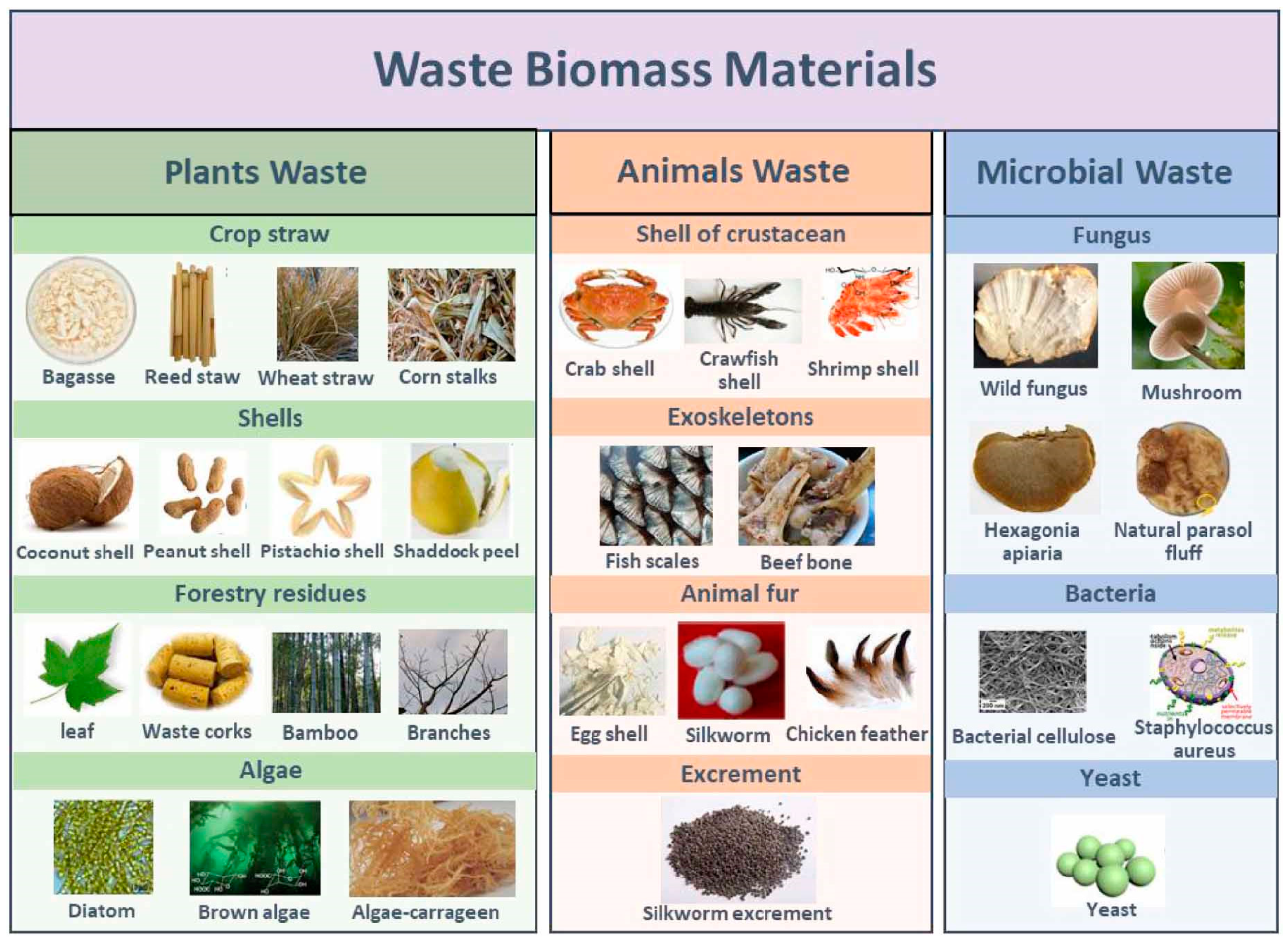
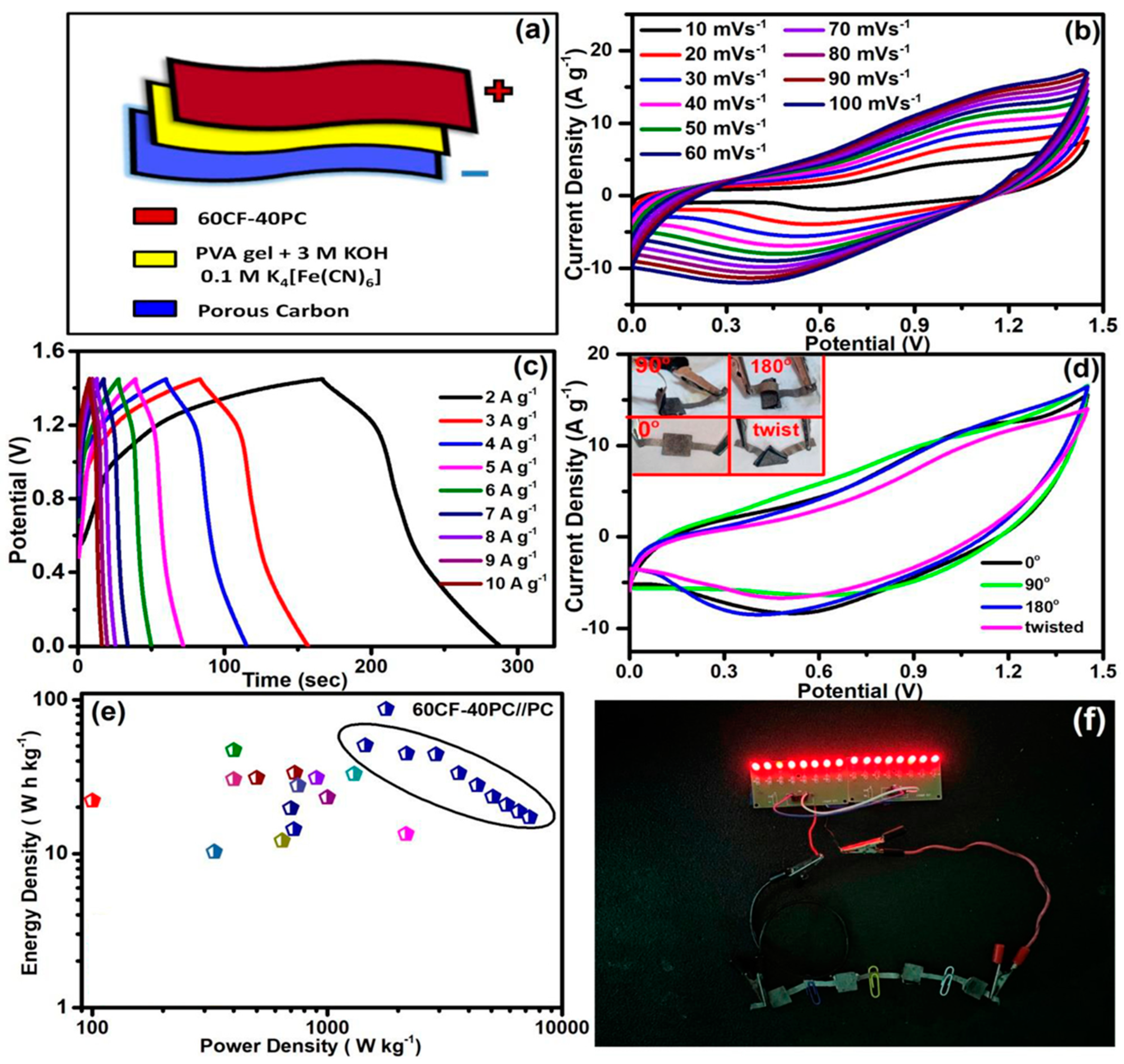



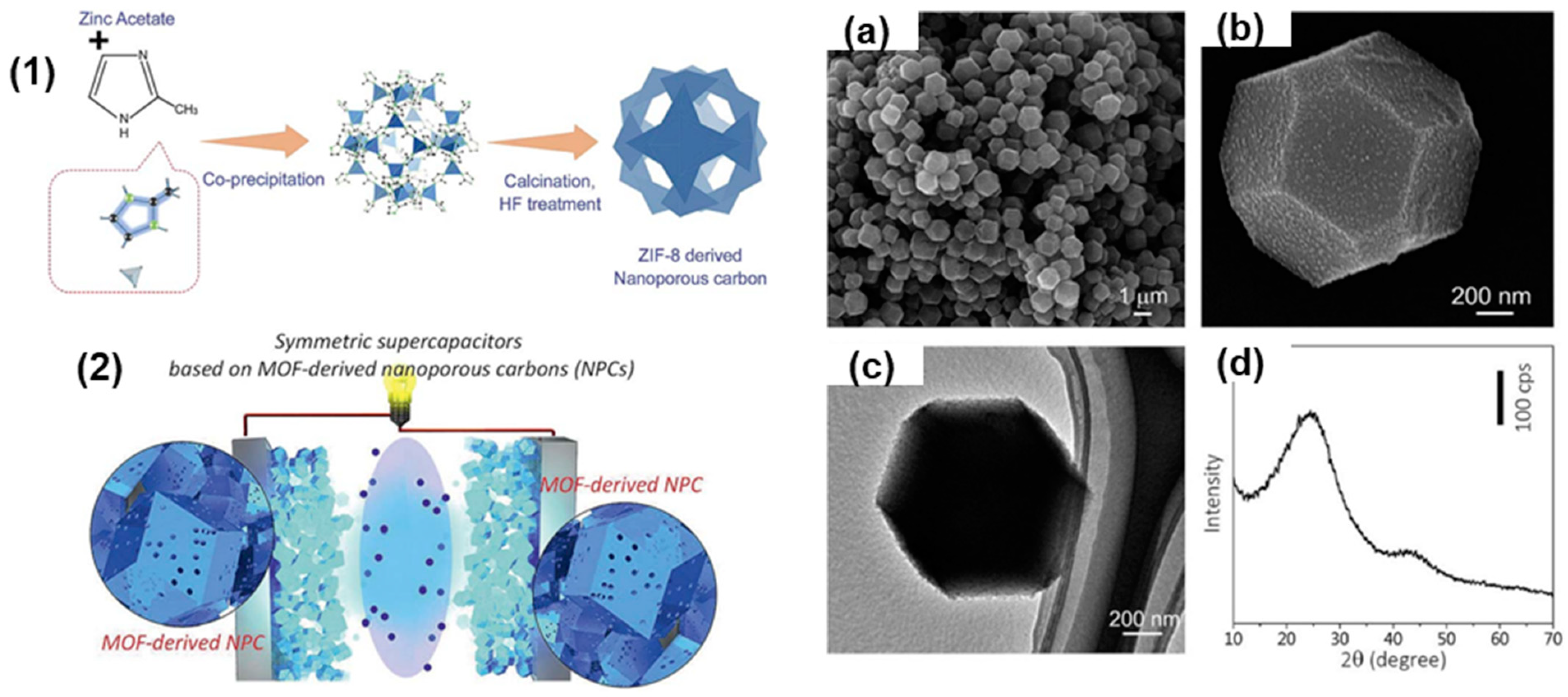



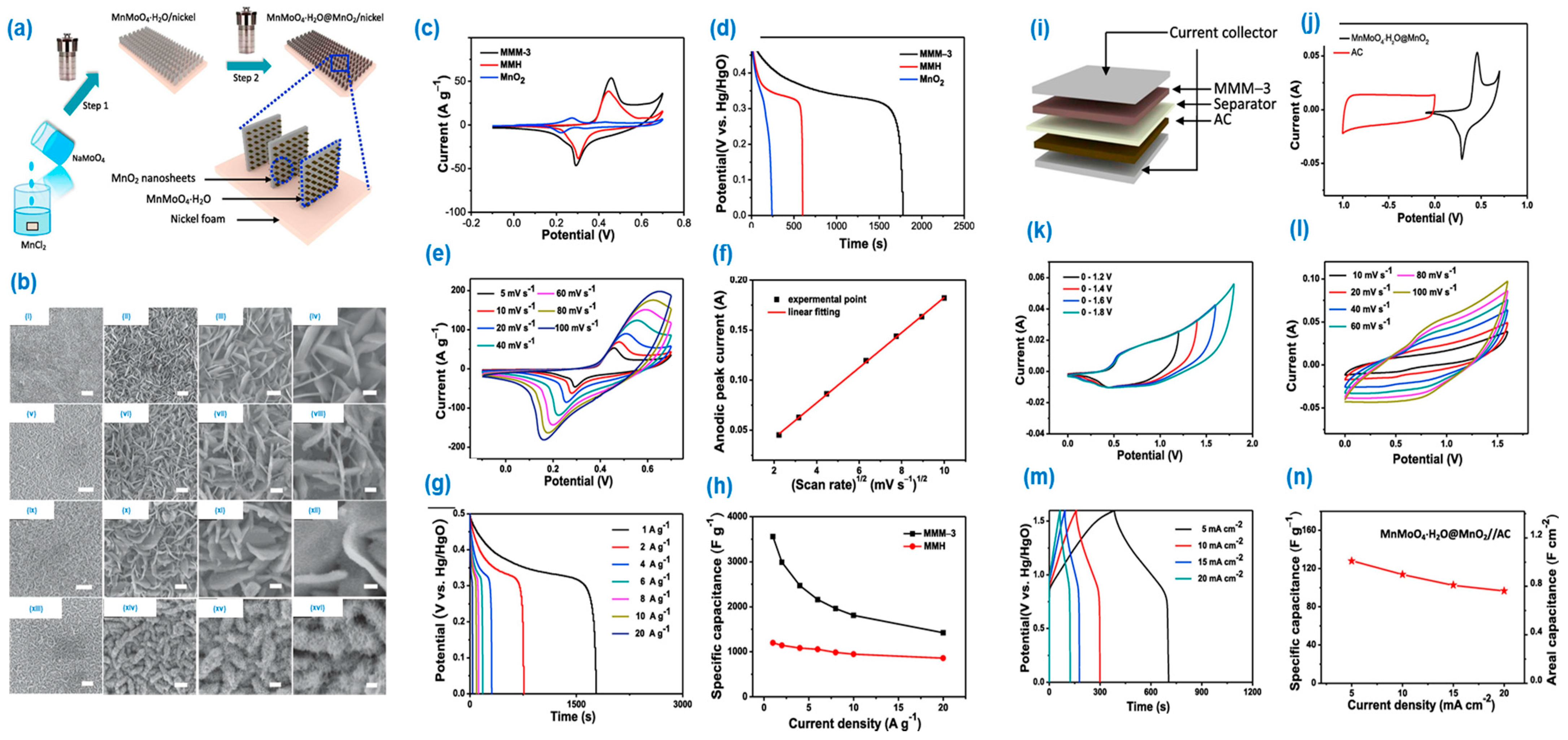

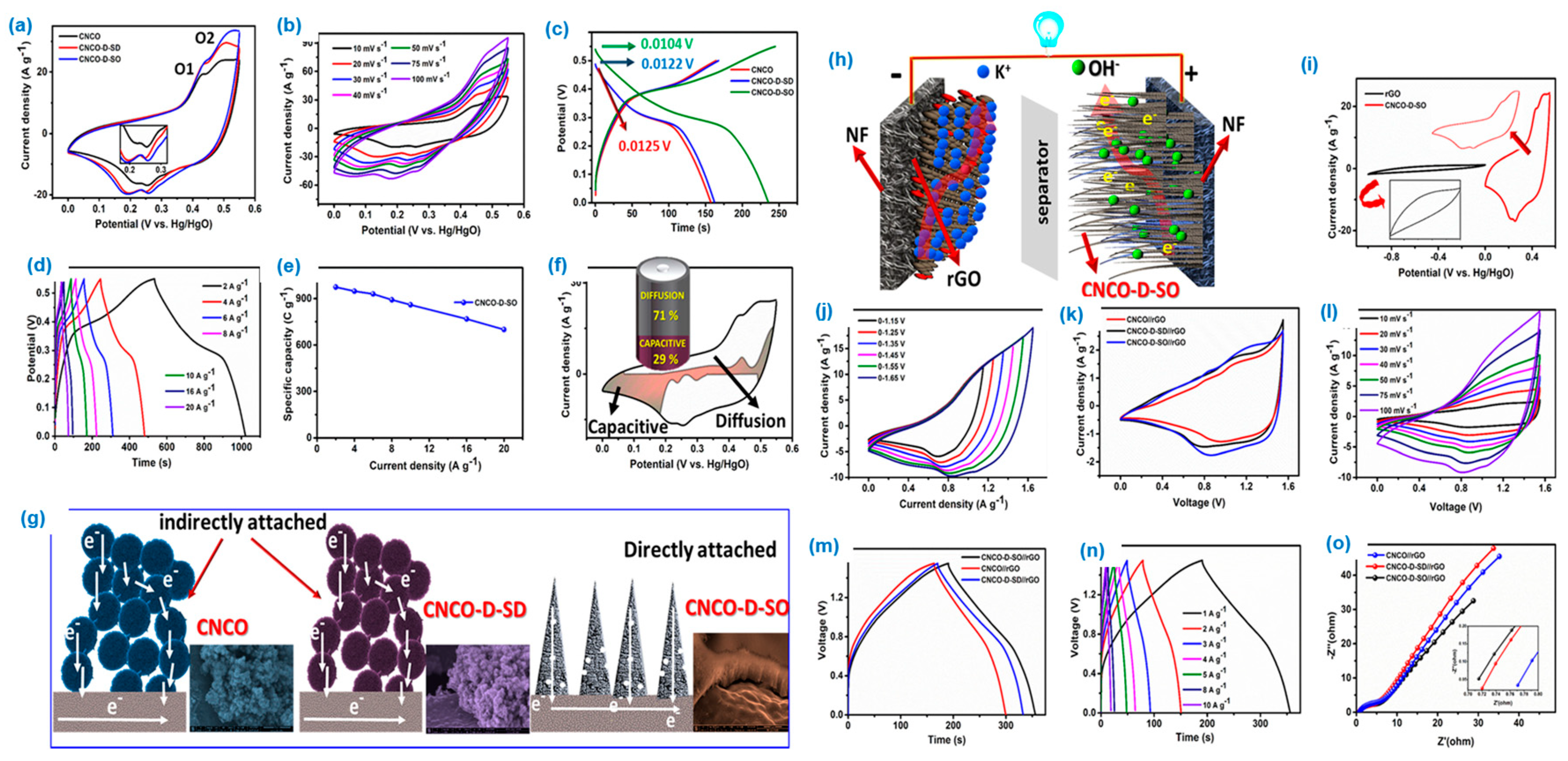

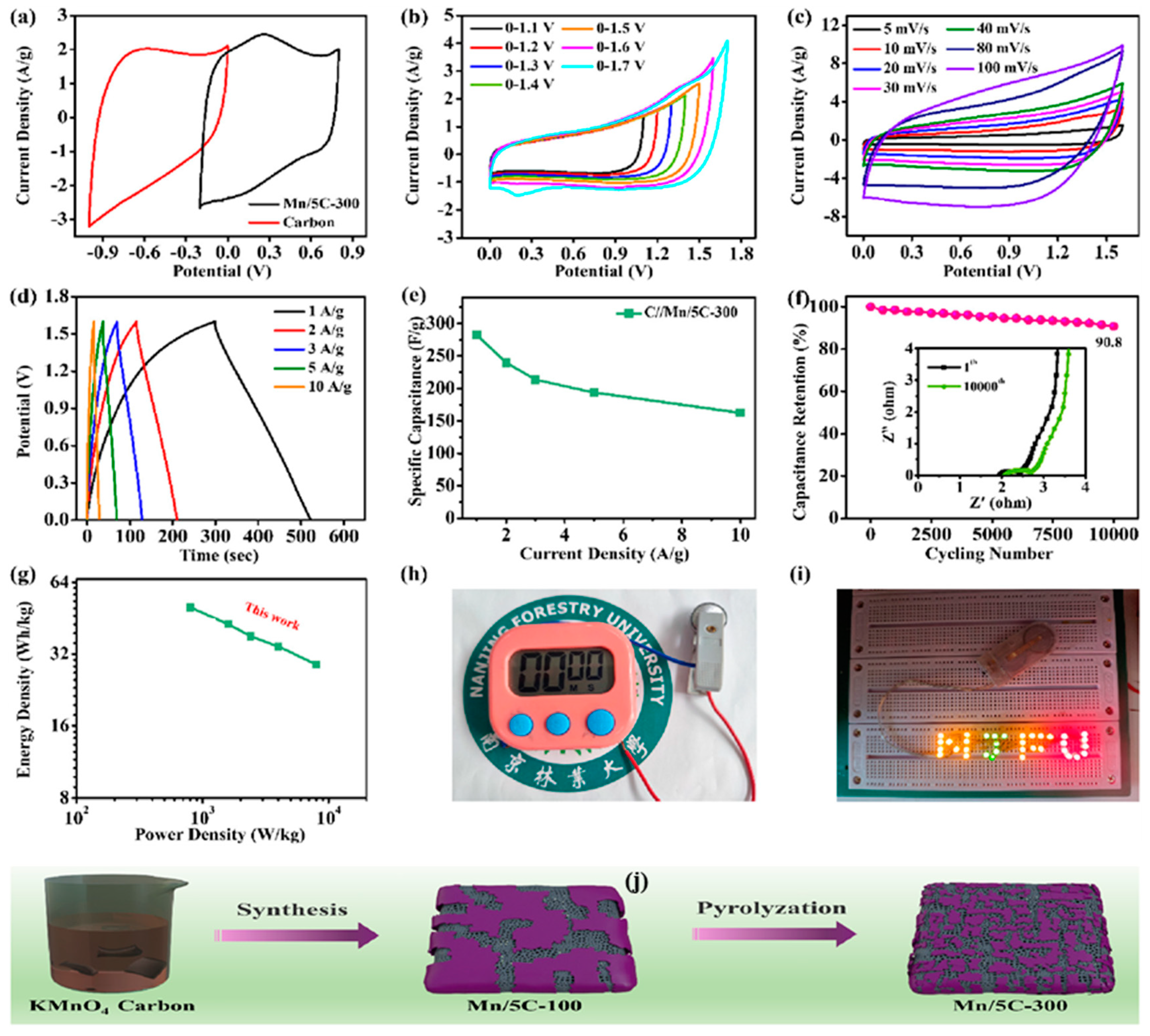


Disclaimer/Publisher’s Note: The statements, opinions and data contained in all publications are solely those of the individual author(s) and contributor(s) and not of MDPI and/or the editor(s). MDPI and/or the editor(s) disclaim responsibility for any injury to people or property resulting from any ideas, methods, instructions or products referred to in the content. |
© 2023 by the authors. Licensee MDPI, Basel, Switzerland. This article is an open access article distributed under the terms and conditions of the Creative Commons Attribution (CC BY) license (https://creativecommons.org/licenses/by/4.0/).
Share and Cite
Arumugam, B.; Mayakrishnan, G.; Subburayan Manickavasagam, S.K.; Kim, S.C.; Vanaraj, R. An Overview of Active Electrode Materials for the Efficient High-Performance Supercapacitor Application. Crystals 2023, 13, 1118. https://doi.org/10.3390/cryst13071118
Arumugam B, Mayakrishnan G, Subburayan Manickavasagam SK, Kim SC, Vanaraj R. An Overview of Active Electrode Materials for the Efficient High-Performance Supercapacitor Application. Crystals. 2023; 13(7):1118. https://doi.org/10.3390/cryst13071118
Chicago/Turabian StyleArumugam, Bharathi, Gopiraman Mayakrishnan, Suresh Kumar Subburayan Manickavasagam, Seong Cheol Kim, and Ramkumar Vanaraj. 2023. "An Overview of Active Electrode Materials for the Efficient High-Performance Supercapacitor Application" Crystals 13, no. 7: 1118. https://doi.org/10.3390/cryst13071118





